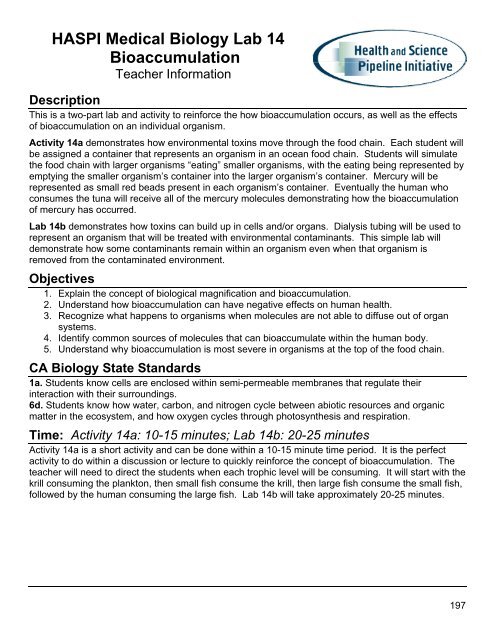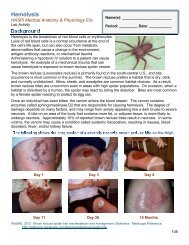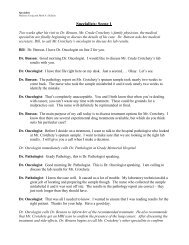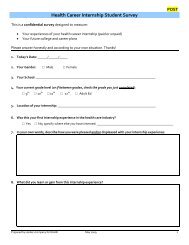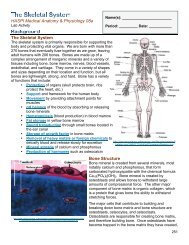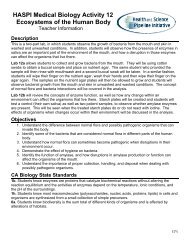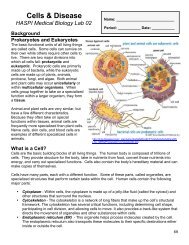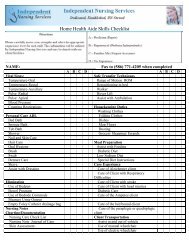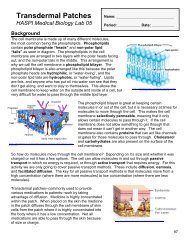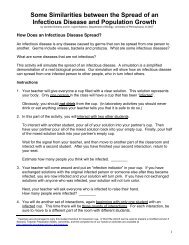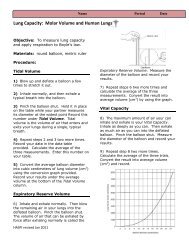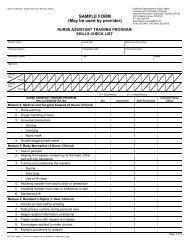14 Bioaccumulation - Info.pdf - haspi
14 Bioaccumulation - Info.pdf - haspi
14 Bioaccumulation - Info.pdf - haspi
You also want an ePaper? Increase the reach of your titles
YUMPU automatically turns print PDFs into web optimized ePapers that Google loves.
HASPI Medical Biology Lab <strong>14</strong><br />
<strong>Bioaccumulation</strong><br />
Teacher <strong>Info</strong>rmation<br />
Description<br />
This is a two-part lab and activity to reinforce the how bioaccumulation occurs, as well as the effects<br />
of bioaccumulation on an individual organism.<br />
Activity <strong>14</strong>a demonstrates how environmental toxins move through the food chain. Each student will<br />
be assigned a container that represents an organism in an ocean food chain. Students will simulate<br />
the food chain with larger organisms “eating” smaller organisms, with the eating being represented by<br />
emptying the smaller organism’s container into the larger organism’s container. Mercury will be<br />
represented as small red beads present in each organism’s container. Eventually the human who<br />
consumes the tuna will receive all of the mercury molecules demonstrating how the bioaccumulation<br />
of mercury has occurred.<br />
Lab <strong>14</strong>b demonstrates how toxins can build up in cells and/or organs. Dialysis tubing will be used to<br />
represent an organism that will be treated with environmental contaminants. This simple lab will<br />
demonstrate how some contaminants remain within an organism even when that organism is<br />
removed from the contaminated environment.<br />
Objectives<br />
1. Explain the concept of biological magnification and bioaccumulation.<br />
2. Understand how bioaccumulation can have negative effects on human health.<br />
3. Recognize what happens to organisms when molecules are not able to diffuse out of organ<br />
systems.<br />
4. Identify common sources of molecules that can bioaccumulate within the human body.<br />
5. Understand why bioaccumulation is most severe in organisms at the top of the food chain.<br />
CA Biology State Standards<br />
1a. Students know cells are enclosed within semi-permeable membranes that regulate their<br />
interaction with their surroundings.<br />
6d. Students know how water, carbon, and nitrogen cycle between abiotic resources and organic<br />
matter in the ecosystem, and how oxygen cycles through photosynthesis and respiration.<br />
Time: Activity <strong>14</strong>a: 10-15 minutes; Lab <strong>14</strong>b: 20-25 minutes<br />
Activity <strong>14</strong>a is a short activity and can be done within a 10-15 minute time period. It is the perfect<br />
activity to do within a discussion or lecture to quickly reinforce the concept of bioaccumulation. The<br />
teacher will need to direct the students when each trophic level will be consuming. It will start with the<br />
krill consuming the plankton, then small fish consume the krill, then large fish consume the small fish,<br />
followed by the human consuming the large fish. Lab <strong>14</strong>b will take approximately 20-25 minutes.<br />
197
Materials Supplies needed for 10 lab groups<br />
Lab <strong>14</strong>a: Biomagnfication<br />
Supply<br />
Provided (P) or<br />
Needed (N)<br />
Quantity<br />
Very small container – plankton P 20<br />
Small container – krill P 10<br />
Medium container – small fish P 6<br />
Medium-large container – tuna P 3<br />
Large container – human P 1<br />
Plastic beads P 100<br />
Graph paper N 40<br />
Lab <strong>14</strong>b: <strong>Bioaccumulation</strong> of Toxins<br />
Supply<br />
Provided (P) or<br />
Needed (N)<br />
Quantity<br />
Dialysis tubing (2 – 6” sections) P 10’<br />
Starch solution P 200 ml<br />
Contaminant A (food coloring) P 20 ml<br />
Contaminant B (tincture of iodine) P 20 ml<br />
Graduated cylinder N 1<br />
Paper towels N 10<br />
Beakers N 20<br />
String – 6”-12” pieces N 40<br />
IMPORTANT: Check the MSDS for safety information on unfamiliar chemicals<br />
Additional <strong>Info</strong>rmation<br />
<br />
<br />
<br />
Each of the containers has already been labeled. The plastic beads each represent a<br />
molecule of mercury. Add 5 beads to each of the plankton containers (the smallest ones),<br />
before the start of activity <strong>14</strong>a.<br />
It is recommended that you purchase and use string to close the dialysis tubing. This way,<br />
dialysis tubing can be reused for additional lab activities as long as it is not too stained from<br />
the procedure.<br />
Contaminants A and B will need to be passed around the classroom to “contaminate” the water<br />
since only one bottle of each will be provided.<br />
Kit Replenishment Instructions- HASPI Supported Sites Only<br />
Funds permitting, HASPI will replace annually:<br />
Dialysis tubing<br />
Laundry starch solution (MUST return bottle for refill)<br />
Contaminant A and B (MUST return bottles for refill)<br />
Not being replaced annually, please recycle and reuse:<br />
ALL containers<br />
Plastic beads<br />
HASPI Medical Biology Lab <strong>14</strong>, <strong>Bioaccumulation</strong>, Teacher <strong>Info</strong>; Revised July 2011 198
Resources and References<br />
Center for Chemistry Education. 2010. Semipermeable Membranes and <strong>Bioaccumulation</strong> –<br />
Instructor Notes. Risks & Choices, Center for Chemistry Education, Miami University (Ohio).<br />
<br />
<br />
www.terrificscience.org<br />
Cooperative Extension Services. 2005. <strong>Bioaccumulation</strong> Basics. University of Kentucky,<br />
College of Agriculture, Agriculture and Natural Resources.<br />
Extension Toxicology Network. 1993. A Pesticide <strong>Info</strong>rmation Project of Cooperative<br />
Extension Offices of Cornell University, Oregon State University, the University of Idaho, and<br />
the University of California at Davis and the Institute for Environmental Toxicology, Michigan<br />
State University. http://extoxnet.orst.edu/tibs/bioaccum.htm<br />
NRDA. 2008. What are PCBs? Wisconsin Department of Natural Resources.<br />
http://dnr.wi.gov/org/water/wm/foxriver/whatarepcbs.html<br />
NIH. 2011. Mercury. U.S. National Library of Medicine, Article 002476.<br />
<br />
<br />
http://www.nlm.nih.gov/medlineplus/ency/article/002476.htm<br />
Heather Peterson, HASPI Curriculum Coordinator. www.<strong>haspi</strong>.org<br />
Edited by Janet Hoff-Kneier, HASPI Program Manager. www.<strong>haspi</strong>.org<br />
Images (in order of appearance)<br />
http://www.whoi.edu/cms/images/oceanus/pangallo_81588.jpg<br />
http://obrien-envproject.wikispaces.com/Allen-Rabideaux<br />
http://www.wiregrassenergynetwork.com/uploads/1/4/9/6/<strong>14</strong>96058/6257066_orig.gif?198<br />
http://www.epa.gov/ost/Fish<br />
http://dnr.wi.gov/org/water/wm/foxriver/images/bioaccumulation.png<br />
Chart from May 2001 study by Arnold Schecter et. al., Journal of Toxicology and<br />
Environmental Health, Part A, 63:1–18.<br />
HASPI Medical Biology Lab <strong>14</strong>, <strong>Bioaccumulation</strong>, Teacher <strong>Info</strong>; Revised July 2011 199
HASPI Medical Biology Lab <strong>14</strong>, <strong>Bioaccumulation</strong>, Teacher <strong>Info</strong>; Revised July 2011 200


